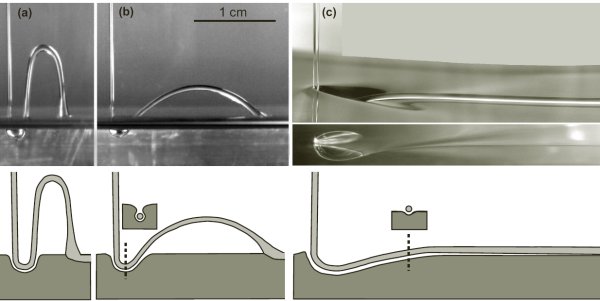Physicists in the US have released astonishing photographs of jets of liquid bouncing along the surface of a bath. The jets, which sometimes resemble an undulating sea serpent, were created by pouring a stream of oil into a rotating bath of the same fluid. The researchers believe that the phenomenon could help improve a number of industrial processes from the casting of molten material to aerating fluids (arXiv: 0707.1721v1).

The photographs were taken by Matthew Thrasher and colleagues at the University of Texas at Austin, who built a rotating oil bath into which a stream of oil was dropped under the watchful eye of a video camera. The photographs reveal that when the stream strikes the surface of the bath, it slides along the surface on a thin layer of air. Furthermore, the force of impact creates a bowl-shaped indentation in the surface of the liquid that acts as a ramp, launching the stream back into the air (see figure “Bouncing jet”). The stream then arcs over the surface and plunges back into the liquid, sometimes emerging in a second arc.
Bouncing was observed in a number of different silicone oils with viscosities ranging from 56 to 560 times that of water. The arc became smaller when the bath was rotated more quickly until the jet no longer lifted off the surface, but rather skimmed its surface (see figure “Skimming”)
Thrasher told Physics Web that a crucial requirement for bouncing is that the layer of air supporting the jet must not break into air bubbles, which would disrupt the stream. He adds that an understanding of why some liquids bounce while others bubble could help improve the metal casting process — in which molten material is poured into a mould and bubbles must be carefully avoided because they weaken the solid metal. Conversely, plunging jets are often used to introduce air bubbles into liquids – a familiar example being bath bubbles that form under a running tap. Therefore Thrasher believes that those designing liquid aeration systems should understand how to avoid the bouncing of fluids.
Thrasher came up with the idea for the experiment when he was pouring oil from one container to another and noticed that the stream of poured oil would sometimes bounce across the surface of the container. In their paper, the researchers suggest several simple experiments for observing bouncing jets in the classroom or even at home.




